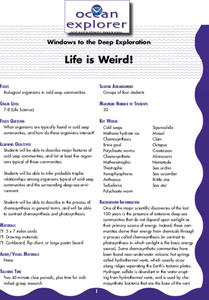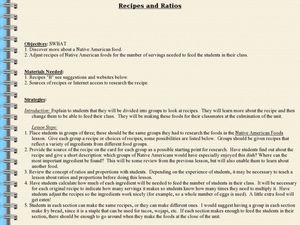Curated OER
Vegetable Twister
Learners review vegetables and their nutrient values and production. In this vegetable production worksheet, students read information about the nutrients in vegetables and how they are grown. Learners participate in a game of Twister to...
Curated OER
Insects!
Students explore the diet of insects. In this "insects" biology lesson, students take a nature walk and collect various natural materials they think may be eaten by insects. Students sort and classify these materials into three diet...
Curated OER
Life is Weird!
Students describe major features of cold seep communities, and list at least five organisms typical of these communities. They infer probable trophic relationships among organisms typical of cold-seep communities and the surrounding...
Curated OER
Animal clues
Fifth graders use general knowledge to make educated guesses about the habitat and survival strategies of animals from Australia, Antarctica and Africa. They research to confirm and check ideas and group animals in a variety of ways.
Curated OER
Survival
Students identify characteristics of Australia, Africa and Antarctica and compare and contrast them to each other. They work together to identify adaptations that animals have used to survive. They also practice classifying animals.
Curated OER
Fred the Fish -- A River Ran Wild
Students apply cause and effect relationships to water pollution in a stream. In this pollution lesson students recognize the importance of clean water in their daily lives. Students accompany "Fred the Fish" as he travels down stream....
Curated OER
Life Systems - Plant Growth
3rd graders will participate in a variety of tasks which help them to understand the basic concepts of plant growth. Research and reporting skills are developed as they gather information from various sources related to the use of plants...
Curated OER
The Oregon Trail
Students use maps and diagrams to examine the Oregon Trail. In groups, they create their own poster of the trail showing the different types of artifacts found along the way. To end the lesson, they identify the sources of water and...
Curated OER
Farm to Lunch: Exploring Agricultural Careers
Fourth graders examine Utah's economic structure and learn about agricultural careers. In this agricultural careers lesson, 4th graders follow agricultural products from their source to the lunch table. Students chart their results to...
Curated OER
Gourmet Chef or Fast Food Mama?
Students examine the contents of a 17th century women's kitchen. Using probate records, they compare them with a historian's record of the same event. They complete an inventory of a kitchen of a women in their own lives.
Curated OER
Studying Japanese Internment with Primary Documents
Eleventh graders view photographs of the Japanese society being interned in camps during World War II in the United States. In groups, they read and discuss Executive Order 9066 and try to determine what group they are trying to focus...
Curated OER
Testing for Vitamin C in different drinks and foods
Students develop an awareness of the use of Vitamin C in helping our environment and gain exposure to chemical procedures and techniques. Students analyze and interpret data by keeping a data sheet and making a bar graph.
Curated OER
Nutrition
Students explore nutrition. In this science lesson plan, students identify and describe the main nutrients in our diets that are needed by the body as a source of energy.
Curated OER
Native American Recipes
Students discover traditional Native American foods. They prepare different recipes and share them with the class. They discuss how the Native American culture is different from their own.
Curated OER
Recipes and Ratios
Young scholars use ratio and proportions to adjust recipe size. In this middle school mathematics instructional activity, students investigate Native American food and adjust the recipe size for said foods to the number of servings...
Curated OER
Energy Conservation
Students complete a variety of activities as they examine forms of energy, use of energy, different technologies to harness energy and the ethical implications of these sources and technologies.
Curated OER
Going Global
Students describe the importance of aquaculture as a source for protein intake by humans globally. They are given a number from 1-3 as they enter the class. All "1's" recieve 10 beans. All "2's" recieve 5 beans. All "3's" recieve 1 bean....
Curated OER
Caribbean Culture Day
Students are introduced to about Caribbean culture through the preparation and sampling of Caribbean food, as well as become familiar with Caribbean folk songs and poetry. They also experience blindness in order to form a deeper...
Curated OER
Eat A Rainbow!
Learners demonstrate the importance of eating fruits and vegetables. In this nutrition lesson, students identify and sort different fruits and vegetables by colors. Learners list reasons why eating fruits and vegetables are important and...
Curated OER
Rainbow Electrophoresis
Students are introduced to the principles of gel electrophoresis and also provides an opportunity for students to practice loading gels and prpetting. In this laboratory activity, food color is used to separate into constituent pigments.
Curated OER
Fatty Acids
Students draw connections between chemical structures of fats and oils (lipids) and their use in food science and nutrition.
Curated OER
JAPANESE CULTURE
First graders explore what life in Japan is like including, home and daily life, food and eating customs, school life, games and sports, holiday customs, and religion.
Curated OER
That Was Then, This Is Now
Students examine the price of food over time. They analyze charts, perform math operations and compare and contrast data about the price of food. They complete worksheets while interperting the charts.
Curated OER
Diet: Find the Carbohydrates
Students discover and discuss the functions of carbohydrates. Once they have taken notes and completed worksheets, they perform experiments using iodine to test for starch. Lesson topics include how carbohydrates are processed by the...

























